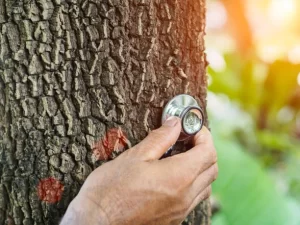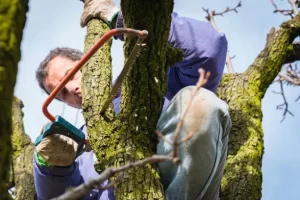Trees are not just a beautiful part of our landscape; they provide shade, clean air, and a habitat for wildlife. However, like all living things, trees can become sick. Recognizing the signs of a sick tree early can save the tree and prevent potential hazards. In this blog, we’ll explore how to identify when a tree is sick and what steps you can take to address the issue.
1. Visible Symptoms on Leaves and Needles
One of the first indicators of a sick tree is discoloration or unusual spots on leaves. Healthy leaves should be vibrant and free from blemishes. If you notice yellowing, browning, or spots, it could indicate a disease or pest problem. For evergreen trees, watch for needles that turn brown or drop prematurely.
- Leaf Spot Diseases: Fungal and bacterial infections can cause spots on leaves. Look for black, brown, or yellow spots that may have a halo or border.
- Chlorosis: This condition causes leaves to turn yellow while veins remain green. It’s often due to nutrient deficiencies or poor soil conditions.
- Premature Leaf Drop: Trees dropping leaves outside of the typical autumn season may be stressed or diseased.
2. Bark Abnormalities
The bark of a tree can reveal much about its health. Healthy bark should be relatively uniform and free from damage. Signs of trouble include:
- Cracks and Splits: Deep cracks or splits in the bark can expose the tree to pests and diseases. These can be caused by environmental stress, physical damage, or disease.
- Cankers: These are dead sections of bark, often sunken and discolored. They can be caused by fungal or bacterial infections and can girdle the tree, cutting off nutrient flow.
- Oozing Sap or Dark Stains: Unusual sap flow or dark, sticky patches can indicate infection or pest activity.

3. Branch and Twig Health
Inspecting the branches and twigs can provide additional clues to a tree’s health.
- Dead or Dying Branches: Dead branches, also known as deadwood, can be brittle and break easily. This can be a sign of disease, pests, or root problems.
- Sparse Foliage: If the tree’s canopy is thin or has bare spots, it may be struggling with a disease or stress.
- Water Sprouts and Suckers: These are abnormal growths that often appear after the tree has experienced stress. They can sap energy from the tree and indicate underlying health issues.
4. Root and Soil Issues
While roots are often out of sight, they can offer significant insights into a tree’s health.
- Exposed Roots: Roots that are visible above the soil can be a sign of erosion, poor planting, or root rot.
- Mushrooms and Fungi: The presence of mushrooms or fungal growth around the base of the tree can indicate root decay or other fungal infections.
- Soil Compaction: Compacted soil can prevent roots from accessing water and nutrients. Look for signs of stress, such as wilting or slow growth.
5. Pest Infestations
Pests can severely impact tree health. Some common pests to watch for include:
- Borers: These insects tunnel into the wood, causing structural damage. Look for small holes and sawdust-like frass.
- Aphids and Scale: These sap-sucking insects can cause leaves to curl, yellow, and drop prematurely. Look for sticky honeydew residue and sooty mold.
- Caterpillars and Beetles: Defoliating insects can strip a tree of its leaves, reducing its ability to photosynthesize.

6. Growth Patterns and General Vigor
A healthy tree should show consistent growth and vigor. Signs that a tree might be sick include:
- Stunted Growth: If a tree is growing more slowly than expected or has stopped growing, it may be under stress.
- Poor Crown Development: A tree’s crown should be full and symmetrical. A thinning or misshapen crown can indicate health problems.
- Unseasonal Behavior: Trees that flower or drop leaves out of season may be experiencing stress or disease.
Taking Action
If you suspect your tree is sick, it’s crucial to take action promptly. Here are steps you can take:
- Consult an Arborist: A certified arborist can diagnose the problem and recommend treatment options. They have the expertise to identify diseases and pests that may not be obvious to the untrained eye.
- Proper Watering and Fertilization: Ensure the tree is getting adequate water and nutrients. Mulching can help retain moisture and improve soil quality.
- Pruning and Removing Deadwood: Regular pruning can improve air circulation and remove diseased or infested branches. Always use clean, sharp tools to avoid spreading disease.
- Pest Management: Use integrated pest management (IPM) techniques to control pests. This may include introducing beneficial insects, using organic pesticides, or employing mechanical controls like traps.
- Soil Testing and Treatment: Conduct a soil test to check for nutrient deficiencies or pH imbalances. Amend the soil as needed to provide the best growing conditions for your tree.
Preventative Measures
Preventing tree sickness is often easier than treating it. Here are some tips to keep your trees healthy:
- Regular Inspections: Regularly check your trees for signs of illness or stress. Early detection can prevent minor issues from becoming major problems.
- Proper Planting Techniques: Ensure trees are planted at the correct depth and in appropriate soil conditions. Avoid planting trees too close to buildings or other structures.
- Maintain Good Hygiene: Remove fallen leaves, branches, and other debris that can harbor pests and diseases. Clean tools regularly to prevent the spread of pathogens.
- Diversify Plantings: Avoid monocultures by planting a variety of tree species. This reduces the risk of a single pest or disease wiping out your entire landscape.
Conclusion
Knowing when a tree is sick involves observing and understanding various symptoms, from leaf discoloration to root issues. By being vigilant and proactive, you can address tree health problems early, ensuring your trees remain robust and beautiful for years to come. If you’re ever in doubt, don’t hesitate to consult with a certified arborist who can provide expert guidance and care. Keeping your trees healthy not only enhances your landscape but also contributes to the overall well-being of our environment.
